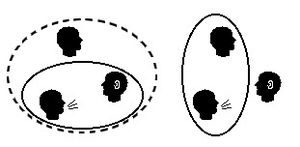In English, if you hear someone say “We’re going to a party,” how do you know if you are going to the party or not? In English you would have to add something like:
- “We’re going to a party. Would you like to come?”
- OR
- “We’re going to a party. Are you bringing a present?”
In many languages, a different form of the ‘we’ pronoun can be used to indicate if the person being spoken to (the addressee, or the ‘you’ implicit in the sentence) is included or excluded.
The inclusive form of the pronoun means the speaker and the addressee(s). The exclusive form of the pronoun means the speaker and someone else but not the addressee(s).
In the above example, the first ‘we’ would be exclusive, and the second would be inclusive.
This is a really useful grammatical distinction (which would probably be very helpful in English!), but might take some time to learn how to understand and use it correctly.
Some languages also distinguish how many people are involved in the ‘we’, with different words for dual, trial and plural.

LEFT: Inclusive RIGHT: Exclusive